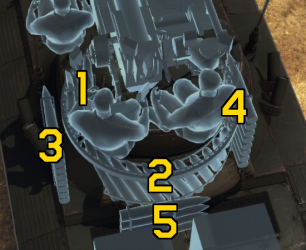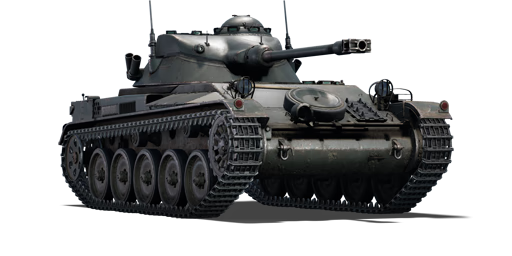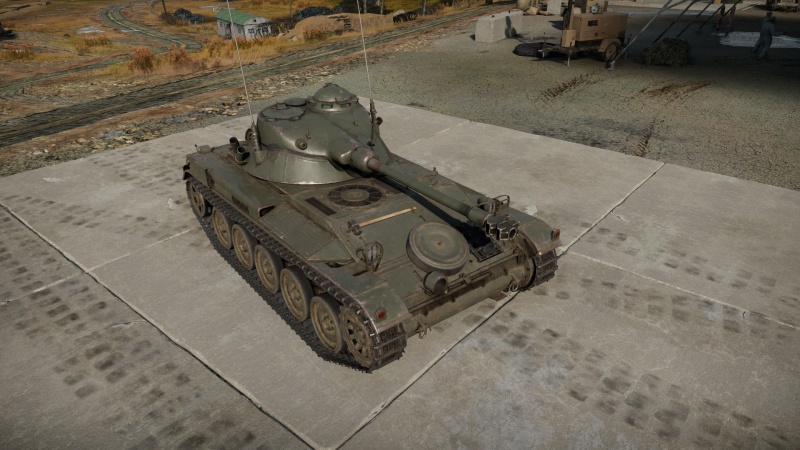AMX-13 (FL11)
| This page is about the French light tank AMX-13 (FL11). For other variants, see AMX-13 (Family). |
Contents
Description
The AMX-13/75 FL-11 is the first subvariant of the AMX-13/75 FL-10, which is the first variant of the AMX-13 light tank family. France had been fighting in the First Indochina War for six years by February 1952. Jean Letourneau, French Minister of State for Relations with Associated States, requested that the most advanced light tank, the AMX-13/75 FL-10, be delivered to cavalry units fighting the Viet Minh. However, the massive FL-10 turret and its long, high-velocity 75 mm SA 50 L/57 tank gun were simply unsuitable for Vietnam. To meet such demands, it was decided that the AMX-13/75 FL-10 would need to be modified to be suited for confined environments within the jungle while also being light enough that it could be transported by air. This was accomplished by equipping the AMX-13/75 FL-10 hull with the new FL-11 turret, primarily designed for the Panhard Engin Blindé de Reconnaissance (E.B.R.) Modèle 1951; it was smaller and lighter, and had a shorter gun that was more suited to the dense jungle environment, being able to more effectively use its high-explosive shell to provide infantry support. The new tank was designated AMX-13/75 FL-11. While it was a successful modification that saved 1.5 tonnes of weight, the vehicle still had to be completely disassembled to be air-transported, and the eventual end of the war meant that the tank would never enter mass-production. The initial batch of 5 units was ultimately sold to Morocco.
Introduced in Update 1.75 "La Résistance", the AMX-13/75 FL-11, like other light tanks, excels as a flanker and scout due to its extremely thin armour. The sloped upper glacis plate and turret front may deflect some rounds from weaker enemy tanks, but everything else will easily penetrate the AMX-13/75 FL-11 armour. Frontal assaults against the adversary should not be carried out with the AMX-13/75 FL-11. Furthermore, due to its sluggish reverse speed, it is difficult to return to cover after being detected; therefore, vigilant awareness of the surroundings is required in combat.
General info
Survivability and armour
This light tank actually has decent armour at its battle rating, especially in the turret front area where 40 mm sloped at ~60° will defeat some small calibre guns. However, although the turret's front armour is good, this does not mean you can just go hull down and be safe, it will only provide you a chance to survive a shot and reposition (a useful tactic to learn when playing the AMX-13). Everywhere else has only 20 mm of flat armour. The upper front plate is sloped at 66°, which may ricochet long-range shots. With only 10 mm of roof armour, stay away from low-flying aircraft as your own armament does not enable you to engage aerial threats.
Armour type:
- Rolled homogeneous armour (hull, turret roof - rear, cupola roof)
- Cast homogeneous armour (turret base, turret, gun mantlet, cupola)
| Armour | Front (Slope angle) | Sides | Rear | Roof |
|---|---|---|---|---|
| Hull | 40 mm (38-40°) Turret base 20 mm (66°) Upper glacis 40 mm (cylindrical) Transmission carter 20 mm (51°) Lower glacis |
20 mm (32-34°) Turret base 20 mm Sides |
20 mm (32-34°) Turret base 15 mm (1°) Top 15 mm (44°) Bottom |
20 mm (24°) Front glacis 10 mm Centre 10 mm (5°) Rear 5 mm Vents |
| Turret | 40 mm (spherical) Turret front 60 mm (spherical) Gun mantlet |
20 mm (cylindrical) | 40 mm (spherical) Turret front 10 mm (18°) Rear half | |
| Cupola | 20 mm (conical) Base 10 mm (spherical) Dome |
20 mm (conical) Outer ring 10 mm (spherical) Centre | ||
Notes:
- Suspension wheels and tracks are 15 mm thick.
- Belly armour is 10 mm thick.
- Storage boxes and mudguards are 4 mm thick.
Mobility
| Game Mode | Max Speed (km/h) | Weight (tons) | Engine power (horsepower) | Power-to-weight ratio (hp/ton) | |||
|---|---|---|---|---|---|---|---|
| Forward | Reverse | Stock | Upgraded | Stock | Upgraded | ||
| Arcade | 68 | 8 | 12.7 | 418 | 515 | 32.91 | 40.55 |
| Realistic | 61 | 7 | 239 | 270 | 18.82 | 21.26 | |
With a power ratio of 26.97 HP/ton in AB, or 15.42 HP/ton in RB (stock!), the AMX-13 (FL11) chassis offers mobility that leave almost nothing to be desired (reverse speed is kind of slow with only -6 km/h). With its wide tracks, even soft terrain is not that hard to cross. The only thing to consider while driving this light tank is obstacles as they can significantly reduce your speed, thus making you vulnerable and/or less effective. One could make very good use of such a fast and small vehicle by avoiding contact while making a large flanking manoeuvre, scouting enemies and popping out sometimes to take down enemies from unexpected angles.
Modifications and economy
Armaments
Main armament
The 75 mm SA49 cannon is quite decent at the BR. Its only flaw being a bad firing arc (shell drops fast with distance), which makes long-range engagements inadvisable. Penetration rates are comparable to those of the Russian F-34 cannon or those of the British QF 6-pounder's stock shot. While not being the best gun at the BR, it certainly provides enough firepower to destroy any enemy's flank. Horizontal drive is fast, allowing for fast reaction shots in close range engagements. As for elevation angles, -6° of depression feels a bit lacking while 13° of elevation is clearly the worst thing about this configuration: you cannot engage air targets. One last thing to consider about your main gun: it is mounted on an oscillating turret, which makes stop-and-shoot tactics ineffective. Coaxial armament is the classic French MAC 31 with 100 rounds loaded and ready to turn those soft targets to shreds. A sweet addition to this tank is 4 smoke launchers located on the lower turret part's back, these can be used either to shield you and your allies from incoming fire, to cover your retreat or to hide your team's movements from enemy sight. Smoke launchers at this low BR prepares players to higher-ranking battlefields and tactic opportunities, make sure to master them.
| 75 mm SA49 | Turret rotation speed (°/s) | Reloading rate (seconds) | |||||||||||
|---|---|---|---|---|---|---|---|---|---|---|---|---|---|
| Mode | Capacity | Vertical | Horizontal | Stabilizer | Stock | Upgraded | Full | Expert | Aced | Stock | Full | Expert | Aced |
| Arcade | 37 | -8°/+15° | ±180° | N/A | 24.8 | 34.3 | 41.6 | 46.0 | 48.9 | 7.80 | 6.90 | 6.36 | 6.00 |
| Realistic | 15.5 | 18.2 | 22.1 | 24.4 | 26.0 | ||||||||
Ammunition
| Penetration statistics | |||||||
|---|---|---|---|---|---|---|---|
| Ammunition | Type of warhead |
Penetration @ 0° Angle of Attack (mm) | |||||
| 10 m | 100 m | 500 m | 1,000 m | 1,500 m | 2,000 m | ||
| M72 shot | AP | 91 | 88 | 78 | 67 | 57 | 49 |
| M48 shell | HE | 10 | 10 | 10 | 10 | 10 | 10 |
| M61 shot | APCBC | 104 | 102 | 93 | 84 | 75 | 68 |
| Shell details | ||||||||||||
|---|---|---|---|---|---|---|---|---|---|---|---|---|
| Ammunition | Type of warhead |
Velocity (m/s) |
Projectile mass (kg) |
Fuse delay (m) |
Fuse sensitivity (mm) |
Explosive mass (TNT equivalent) (g) |
Ricochet | |||||
| 0% | 50% | 100% | ||||||||||
| M72 shot | AP | 619 | 6.3 | - | - | - | 47° | 60° | 65° | |||
| M48 shell | HE | 463 | 6.3 | 0.2 | 0.1 | 666 | 79° | 80° | 81° | |||
| M61 shot | APCBC | 618 | 6.79 | 1.2 | 14 | 63.7 | 48° | 63° | 71° | |||
| Smoke shell characteristics | ||||||
|---|---|---|---|---|---|---|
| Ammunition | Velocity (m/s) |
Projectile mass (kg) |
Screen radius (m) |
Screen deploy time (s) |
Screen hold time (s) |
Explosive mass (TNT equivalent) (g) |
| M89 | 259 | 3 | 9 | 5 | 20 | 50 |
Ammo racks

| Full ammo |
1st rack empty |
2nd rack empty |
3rd rack empty |
4th rack empty |
5th rack empty |
Visual discrepancy |
|---|---|---|---|---|---|---|
| 37 | 32 (+5) | 21 (+16) | 13 (+24) | 5 (+32) | 1 (+36) | No |
Note:
- Shells are modeled individually and disappear after having been shot or loaded.
Machine guns
| 7.5 mm MAC 31 | ||||
|---|---|---|---|---|
| Mount | Capacity (Belt) | Fire rate | Vertical | Horizontal |
| Coaxial | 4,950 (150) | 551 | N/A | N/A |
The small calibre of the MAC 31 machine gun makes it largely ineffective against all armoured vehicles but the ones with an open compartment. It still can be used to ping targets as a rangefinding help or to mow down minor obstacles blocking your line of sight.
Usage in battles
The AMX-13 (FL11), in line with most light tanks, shines best as a flanker and scout, due to its almost non-existent armour. Some shots against lower tiers can be bounced off by the sloped upper glacis plate and turret front, but anywhere else will get penetrated with ease. A sub-par gun without APHE ammunition means frontal engagements are mostly out of the question.
Scout and flank, as any other light tank should. The AMX-13 (FL11) cannot stand up to direct assaults from the enemy; it has irrelevant armour, decent speed, a useable gun with lacking depression (especially facing forward), and only 3 crew. The bad reverse speed also makes it unable to retreat behind cover once discovered, so caution in engagements is advised. It is also worth noting that the low velocity and high drop rate of its shells allow the FL11 to engage from behind slopes without having to reveal itself.
Pros and cons
Pros:
- Decent penetration
- Fairly small and has a low profile: easy to hide, helps scouting
- Good mobility
- Has smoke launchers
- Poorly aimed shots may bounce off the 40 mm sloped turret
- Unlike most light tanks, impervious to HMG from the front
- Engine in the front protects crew in head on engagements
- Has access to the same APCBC shot with HE filler as the M4 Shermans
Cons:
- Very bad gun handling
- Long reload time
- Low velocity cannon: long-range shots are hard to land
- Unstable cannon pitch up when firing, makes it difficult to stay on target
- Unstable cannon pitch up when braking, makes it difficult and slow to acquire targets right after stopping
- Mediocre gun depression (especially facing forward)
- Bad reverse
- Bad elevation and no top-mounted MG makes it vulnerable to aircraft
- Turret area is filled with ammo
- Lamps on the hull will stop you from aiming from specific angles
History
Development
In 1952, the First Indochina War had been raging for six years. The French Army was facing a better and better armed enemy and their cavalry units were still equipped with WW2 tanks like the M24 or the M5A1. The French government decided to send the latest developed French tank, the AMX-13, in Indochina. However, the AMX-13 needed to undergo modifications for the South-Eastern theater. The large FL-10 autoloader turret and the long 75 mm gun made the AMX-13 unadapted for the logistical constraints of the colonial conflict (limited air transport capabilities and combat in constricted urban environments).
That's why a new turret was installed (the FL-11 equipping the Panhard EBR reconnaissance armoured car) which was smaller, lighter and sporting a shorter 75 mm gun. The new turret made the tank less tall and shorter in overall length. However, the new turret was cramped, which was detrimental to the manual reloading of the gun. No major modification was brought to the hull: the only noticeable difference was the shift from 4 track return rollers to 2.
The production started in 1954 with an order for 20 units but only 5 were produced. By that time, the First Indochina War had come to an end and the need for such an urban combat vehicle had disappeared.
Combat usage
The 5 AMX-13 (FL11) were allocated to the 2nd Foreign Cavalry Regiment in Oujda, Morocco. They never saw combat action and were sold in 1956 to the Moroccan Army following the country's independence. The light tanks stayed in the Moroccan arsenal until 1973. It is unclear if they ever saw combat under Moroccan flag.
Media
- Skins
- Videos
See also
- Vehicles equipped with the same chassis
- Other vehicles of similar configuration and role
External links
| Ateliers de construction d'Issy-les-Moulineaux (AMX) | |
|---|---|
| Light tanks | |
| AMX-13 | AMX-13-M24 · AMX-13 (FL11) · AMX-13 · AMX-13 (SS.11) · AMX-13-90 · AMX-13 (HOT) |
| Armoured cars | AMX-10RC |
| Medium tanks | AMX M4 · AMX-50 (TOA100) |
| MBTs | |
| AMX-30 | AMX-30 · AMX-30 ACRA · AMX-30 (1972) · AMX-30B2 · AMX-30B2 BRENUS · AMX-30 Super |
| AMX-32/40 | AMX-32 (105) · AMX-32 · AMX-40 |
| Heavy tanks | AMX-50 Surbaissé · AMX-50 Surblindé |
| Tank destroyers | ELC bis · AMX-50 Foch |
| SPAAGs | AMX-13 DCA 40 · AMX-30 S DCA |
| Export | AMX-13 |
| France light tanks | |
|---|---|
| AMC.34/35 | AMC.34 YR · AMC.35 (ACG.1) |
| H.35/39 | H.35 · H.39 · H.39 "Cambronne" |
| AMX-13 | AMX-13 (FL11) · AMX-13-M24 · AMX-13 · AMX-13 (SS.11) · AMX-13-90 · AMX-13 (HOT) |
| Wheeled | AML-90 · AMX-10RC · Vextra 105 |
| AMD.35 | AMD.35 · AMD.35 (SA35) |
| E.B.R. | E.B.R. (1951) · E.B.R. (1954) · E.B.R. (1963) |
| Other | FCM.36 · R.35 (SA38) · Char 25t · MARS 15 · VBCI-2 (MCT30) |
| Austria | SK-105A2 |
| Great Britain | ▄Crusader Mk.II |
| Netherlands | CV 9035NL |
| USA | LVT-4/40 · ▄M3A3 Stuart |





